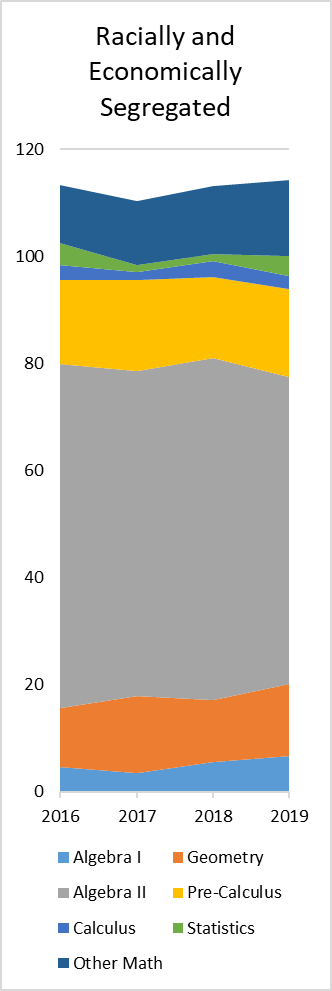By Vandeen A. Campbell, Ph.D.
The New Jersey State Policy Lab, in collaboration with the Joseph C. Cornwall Center for Metropolitan Studies, is releasing a report that examines patterns in high school math course-taking across New Jersey (NJ).
Math Enrollment in 11th Grade by School Segregation, 2016-2017 through 2019-2020
Source: Authors’ calculations based on data from New Jersey Department of Education School Performance Reports Database: https://rc.doe.state.nj.us/download. NOTE: According to NJDOE School Performance Reports Reference Guides, students are counted in each course in which they are enrolled. If students take multiple math courses, the total percent of students enrolled in math will exceed 100%.
Disparities in secondary math course-taking trends suggest that racially and economically mixed schools provide an advantage in accelerating proportionally more students along the math sequence compared to racially (90%+ minority) and/or economically segregated schools (50%+ economic disadvantage). A typical high school math course sequence would start with Algebra I, Geometry, Algebra II, and continue with higher-level courses such as Pre-Calculus and Calculus. If the opportunity is offered, academically prepared students can take Algebra I earlier in middle school, blazing a path to more advanced math options.
In NJ, a clear gap in early access to Algebra I is found where middle schools segregated racially and economically offer far lower rates of access to Algebra I than those in mixed enrollment schools – 53% compared to 93% respectively.
Percentage of NJ Schools with Middle Grades Having Enrollment in Algebra I in Grades 6-8 by School Segregation, 2016-2017 through 2019-2020
Source: Authors’ calculations based on data from New Jersey Department of Education School Performance Reports Database: https://rc.doe.state.nj.us/download.
Proportionally more students in mixed enrollment schools follow a sequence of math courses that permit them to advance to higher level math courses during their high school studies. Where the majority of 9th graders in schools segregated racially and/or economically are taking Algebra I, the standard math course upon entering high school, about 30% of freshmen in racially and economically mixed high schools have moved on to Geometry, compared to about 18% in segregated schools. That 10+ percentage point gap in taking more advanced math courses each grade does not appear to close. By 11th grade, the gap is solidified as exhibited by the 15-percentage point difference in the combined Pre-Calculus and Calculus enrollment in mixed enrollment schools (33.9%) as compared with enrollment in these courses in schools with larger shares of economically disadvantaged students (17.8%) or in schools with racial minority and economically disadvantaged students (18.9%).
The report also examines trends in math enrollment at schools based on their proportions of English learners (EL) and students with disabilities (SWD) – student populations which have also been historically disadvantaged in terms of math course-taking. For schools with the highest proportions of ELs and SWDs, the trends mirror those for segregated schools. In addition, for each grade level, schools with the highest proportions of ELs enroll 20% or more of their students in an ambiguous ‘Other Math’ category, rates sometimes double those at schools with lower proportions of ELs and SWDs. This finding leaves open a question for further research as to whether these “other math” courses reflect lower-level or innovative math course-taking in these schools.
Taking advanced math courses in middle school and high school improves math achievement and increases the likelihood of college enrollment and access to science, technology, engineering, and mathematics (STEM) fields. Therefore, closing these gaps will be a critical task for the state and school districts.
The report features positive outliers in NJ–that is, schools with large shares of racial minority students and/or economically disadvantaged students with no special admission criteria or magnet program that maintain rates of enrollment in higher-level math courses comparable to mixed enrollment schools. These schools present an opportunity for local learning about successful policies and practices in math departments around the state. The report also reviews promising interventions and policies implemented across the U.S. in recent years.





